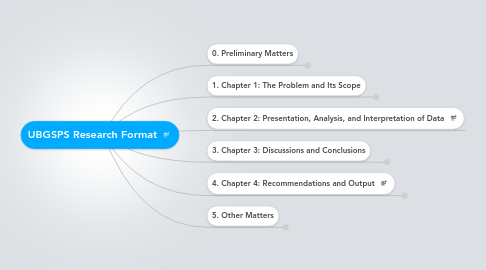
1. 0. Preliminary Matters
1.1. a. Title
1.1.1. 12 to 15 words, not more than 2 lines
1.2. b. Abstract (200 words)
1.2.1. 1. Introduction (one sentence)
1.2.2. 2. Chief purpose or main objectives of the study (one sentence)
1.2.3. 3. Methods (two to three sentences)
1.2.3.1. Research design
1.2.3.2. Environment
1.2.3.3. Population and sample
1.2.3.4. Research ethics
1.2.4. 4. Results
1.2.5. 5. Conclusions
1.3. c. Executive Summary for Dissertations (500 words)
1.4. d. Keywords
1.4.1. Discipline of the Study
1.4.2. Concepts / Principal Variables Investigated
1.4.3. Methods or Processes
1.4.4. Locale :: Geography of the Study
1.5. e. Preliminary pages in the final paper
1.5.1. 1. Approval Sheet
1.5.2. 2. Certificate of Results in Written Comprehensive Examination
1.5.3. 3. Certificate of Dissertation Acceptability
1.5.4. 4. List of Tables (if few, list of tables and figures)
1.5.5. 5. List of Figures
1.5.6. 6. Table of Contents
1.5.7. 7. Dedication
2. 1. Chapter 1: The Problem and Its Scope
2.1. a. Introduction
2.1.1. Start from broad view of interests in your field
2.1.2. Focus narrows to study
2.1.3. Justify your research
2.1.4. Statement of purpose of the study
2.1.5. 400-500 words
2.2. b. Objectives
2.2.1. Limit to 2 or 3 objectives
2.2.2. Stated in terms of what the researcher will do with the data
2.2.3. Rather than research activities
2.3. c. Review of Related Theories, Concepts, and Literature
2.3.1. > 12 citations
2.3.2. > 3 continents
2.3.3. > 6K words (7K max)
2.4. d. Conceptual Framework
2.5. e. The Problem
2.5.1. 1. Statement of the Problem
2.5.2. 2. Statement of the hypothesis (optional)
2.5.3. 3. Significance of the study
2.6. f. Research methodology
2.6.1. 1. Design
2.6.2. 2. Environment
2.6.3. 3. Participants
2.6.4. 4. Instruments
2.6.5. 5. Data Procedures
2.6.6. 6. Statistical Treatment
2.7. g. Definition of terms
2.8. h. Organization of the Study**
3. 2. Chapter 2: Presentation, Analysis, and Interpretation of Data
4. 3. Chapter 3: Discussions and Conclusions
4.1. Discussions
4.1.1. Experimental studies separate Results & Discussions
4.1.2. Social science studies integrate Results & Discussions
4.1.3. Include
4.1.3.1. Summary of findings in answer to your research questions
4.1.3.2. Tables and graphs
4.1.3.3. References to tables /graphs
4.1.4. Exclude
4.1.4.1. Raw data, formulas & procedures
4.1.4.2. Redundant data presentations
4.1.4.3. Too many figures
4.1.4.4. Interpretation of results
4.1.5. Must be supported by continental literature.
4.1.6. Data Presentation by Objectives
4.1.7. Theory Generation
4.2. Conclusions
4.2.1. Answers the objectives
4.2.2. Judgment of the findings on study theories
5. 4. Chapter 4: Recommendations and Output
5.1. Recommendations
5.1.1. Should be based on the table(s).
5.1.2. Inputs should only include universal application.
5.2. Output
6. 5. Other Matters
6.1. 1. Acknowledgements
6.2. 2. Bibliography
6.3. 3. Annexes
6.3.1. Transmittal Letter
6.3.2. Research Instrument*
6.3.3. Timetable of Activities
6.3.4. Research Budget*
6.3.5. Appointment and Contract for Advisorship
6.3.6. Permission letters
6.3.7. Request for the Conduct of Oral Defense
6.3.8. Permission Letter to Conduct Research
6.4. 4. Researcher’s Bio
6.5. 5. Form & Style Guidelines
6.5.1. Font: any sans serif font size 12
6.5.2. Pagination: Utilize auto paging/ table of content generating feature of word processor
6.5.3. Margins: Left-1.5”; top 1.2”, right 1.2, bottom 1.2”
6.5.4. Line Spacing: Double space; indention at beginning of paragraphs
6.5.5. Tables & Figures: Table title on top. Figure title below
6.5.6. Paper size: 8½ inches by 11 inches
6.5.7. Citations: APA format
6.5.8. Final copies: at least 2 hard bound copies (1 for CHED RO, 1 for library) and an electronic copy in PDF or non-editable format
